
Embracing Disruption Lessons Learned
In the beginning of 2021, The Gifford Foundation launched its newest capacity building program with a cohort of five CNY-based nonprofits. These organizations are now roughly halfway through the 15-month process which guides them through an intensive self-assessment and planning curriculum led by trained consultants.
Published November 9th, 2021
“When I ask an organization where they expect to be in 2 or 3 years, I usually get this confused look and they say, ‘I’m just trying to figure out if I can host an in-person event next month’,” says consultant Steve Schack. “Embracing Disruption has allowed them to take meaningful looks at their organizations and start putting in some long-term sustainability.”
Gifford has a history of investing heavily in previous capacity building programs like ADVANS and POWER. Embracing Disruption carries on that tradition but has been built specifically with contemporary challenges in mind. “I think it’s fair to say that we all want the orchestra to be here in 100 years,” says Symphoria Executive Director Pamela Murchison.
We gathered perspectives from a range of consultants and participants from Gifford’s newest capacity building program, Embracing Disruption, to see what they learned and listen to their opinions on the program’s impact.
“To be going through what the community has been going through over the past 18 months, but to also be working on long-term strategy – just felt really good.”
Through Embracing, Symphoria has been able to reinvigorate both their marketing and fundraising structures including hiring a full-time marketing specialist and launching a $2 million major gift campaign. They are not alone. “A unique trend with this cohort is that everyone has been focused on their business model and financial resources,” says Gifford’s Associate Director Lindsay McClung who worked closely with Jennifer Bonnett of the Nonprofit Lifecycles Institute to design the program over the course of 2020. “We built this program to be flexible and nimble and integrate with what organizations were doing,” says Bonnett. “The program created space for them to not just look at the day to day need but also long-term strategy.”
Generalizing about the impact of the pandemic on the stability and well-being of nonprofits can be challenging. Some organizations were hit hard financially as they watched their normal revenue streams dry up overnight. In other cases, government relief funding left some nonprofits in an even stronger financial position than they were in before. Yet the common thread between both of these extremes is making space for deliberate, long-term planning.

The Embracing Disruption program incorporates The Nonprofit Lifecycles Institute’s table leg analogy to help organizations visualize and assess their structure.
Central to structuring both the self-assessment and strategic planning processes within Gifford’s capacity building programs is the Lifecycles model. This approach to nonprofit development teaches organizations to see their mission and programs as resting upon a table with four legs: management, governance, financial resources, and administrative systems. If these legs become imbalanced, the consequences can be dire.
Many of the participants within Embracing Disruption have used this approach to identify which aspects of their organization need the most work – maximizing the impact of their efforts. “I never regret doing this program because it helps me focus on things that are really important to the organization,” says Pam Murchison of Symphoria.
“Things that may not be urgent but are very important to our long-term health. We’re in an ultra-marathon, this is not a sprint. And so, it’s been impossible to calculate the value of having the time and space to do this.”
Jennifer Bonnett frequently reminds interested nonprofits that they can begin this work anytime – even outside of a formal capacity building program like Embracing. As is often the case, the most challenging step is getting started. “Pull a team together and do a self-assessment,” she recommends. “That’s a great way for them to start to do this work for themselves.” There will always be the temptation to focus solely on the services that your organization provides and the mini emergencies that arise day-to-day. But as Embracing participants are learning, forcing oneself to pull away and take the long view is as rewarding as it is necessary. “If you think it’s scary to start making a long-term plan,” advises Lindsay McClung, “consider how scary it is operating without one.”
Stay in touch
We have a lot of stuff in the works - don't be the last to know.


